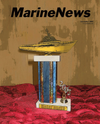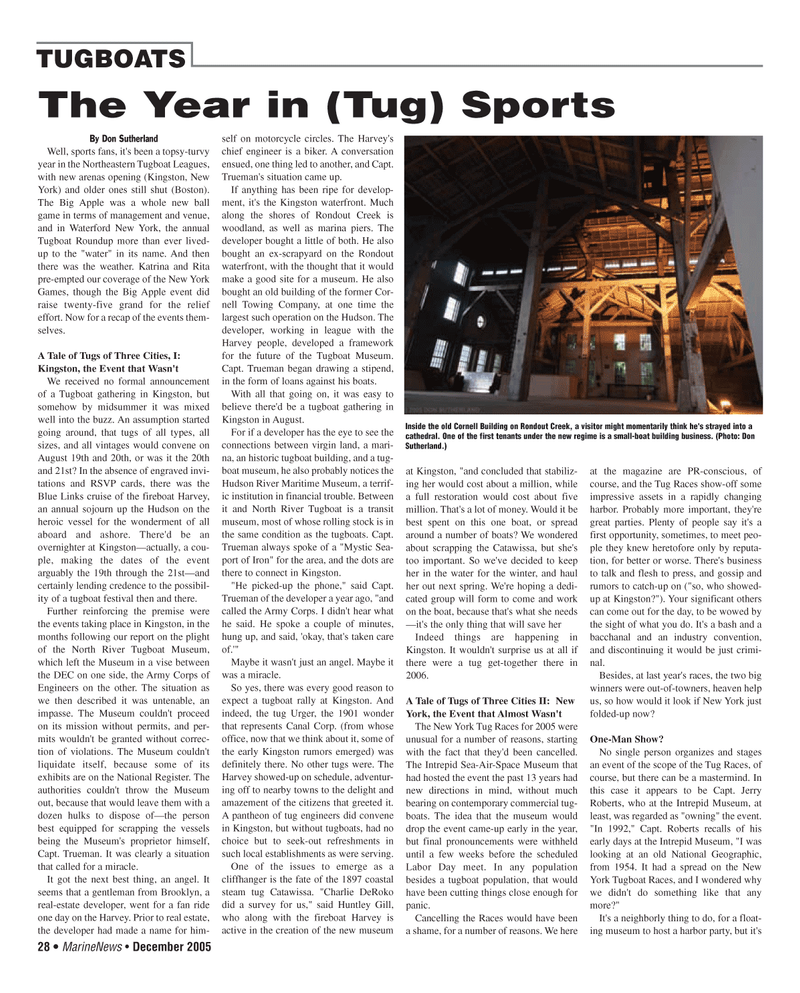
Page 28: of Marine News Magazine (December 2005)
Read this page in Pdf, Flash or Html5 edition of December 2005 Marine News Magazine
By Don Sutherland
Well, sports fans, it's been a topsy-turvy year in the Northeastern Tugboat Leagues, with new arenas opening (Kingston, New
York) and older ones still shut (Boston).
The Big Apple was a whole new ball game in terms of management and venue, and in Waterford New York, the annual
Tugboat Roundup more than ever lived- up to the "water" in its name. And then there was the weather. Katrina and Rita pre-empted our coverage of the New York
Games, though the Big Apple event did raise twenty-five grand for the relief effort. Now for a recap of the events them- selves.
A Tale of Tugs of Three Cities, I:
Kingston, the Event that Wasn't
We received no formal announcement of a Tugboat gathering in Kingston, but somehow by midsummer it was mixed well into the buzz. An assumption started going around, that tugs of all types, all sizes, and all vintages would convene on
August 19th and 20th, or was it the 20th and 21st? In the absence of engraved invi- tations and RSVP cards, there was the
Blue Links cruise of the fireboat Harvey, an annual sojourn up the Hudson on the heroic vessel for the wonderment of all aboard and ashore. There'd be an overnighter at Kingston—actually, a cou- ple, making the dates of the event arguably the 19th through the 21st—and certainly lending credence to the possibil- ity of a tugboat festival then and there.
Further reinforcing the premise were the events taking place in Kingston, in the months following our report on the plight of the North River Tugboat Museum, which left the Museum in a vise between the DEC on one side, the Army Corps of
Engineers on the other. The situation as we then described it was untenable, an impasse. The Museum couldn't proceed on its mission without permits, and per- mits wouldn't be granted without correc- tion of violations. The Museum couldn't liquidate itself, because some of its exhibits are on the National Register. The authorities couldn't throw the Museum out, because that would leave them with a dozen hulks to dispose of—the person best equipped for scrapping the vessels being the Museum's proprietor himself,
Capt. Trueman. It was clearly a situation that called for a miracle.
It got the next best thing, an angel. It seems that a gentleman from Brooklyn, a real-estate developer, went for a fan ride one day on the Harvey. Prior to real estate, the developer had made a name for him- self on motorcycle circles. The Harvey's chief engineer is a biker. A conversation ensued, one thing led to another, and Capt.
Trueman's situation came up.
If anything has been ripe for develop- ment, it's the Kingston waterfront. Much along the shores of Rondout Creek is woodland, as well as marina piers. The developer bought a little of both. He also bought an ex-scrapyard on the Rondout waterfront, with the thought that it would make a good site for a museum. He also bought an old building of the former Cor- nell Towing Company, at one time the largest such operation on the Hudson. The developer, working in league with the
Harvey people, developed a framework for the future of the Tugboat Museum.
Capt. Trueman began drawing a stipend, in the form of loans against his boats.
With all that going on, it was easy to believe there'd be a tugboat gathering in
Kingston in August.
For if a developer has the eye to see the connections between virgin land, a mari- na, an historic tugboat building, and a tug- boat museum, he also probably notices the
Hudson River Maritime Museum, a terrif- ic institution in financial trouble. Between it and North River Tugboat is a transit museum, most of whose rolling stock is in the same condition as the tugboats. Capt.
Trueman always spoke of a "Mystic Sea- port of Iron" for the area, and the dots are there to connect in Kingston. "He picked-up the phone," said Capt.
Trueman of the developer a year ago, "and called the Army Corps. I didn't hear what he said. He spoke a couple of minutes, hung up, and said, 'okay, that's taken care of.'"
Maybe it wasn't just an angel. Maybe it was a miracle.
So yes, there was every good reason to expect a tugboat rally at Kingston. And indeed, the tug Urger, the 1901 wonder that represents Canal Corp. (from whose office, now that we think about it, some of the early Kingston rumors emerged) was definitely there. No other tugs were. The
Harvey showed-up on schedule, adventur- ing off to nearby towns to the delight and amazement of the citizens that greeted it.
A pantheon of tug engineers did convene in Kingston, but without tugboats, had no choice but to seek-out refreshments in such local establishments as were serving.
One of the issues to emerge as a cliffhanger is the fate of the 1897 coastal steam tug Catawissa. "Charlie DeRoko did a survey for us," said Huntley Gill, who along with the fireboat Harvey is active in the creation of the new museum at Kingston, "and concluded that stabiliz- ing her would cost about a million, while a full restoration would cost about five million. That's a lot of money. Would it be best spent on this one boat, or spread around a number of boats? We wondered about scrapping the Catawissa, but she's too important. So we've decided to keep her in the water for the winter, and haul her out next spring. We're hoping a dedi- cated group will form to come and work on the boat, because that's what she needs —it's the only thing that will save her
Indeed things are happening in
Kingston. It wouldn't surprise us at all if there were a tug get-together there in 2006.
A Tale of Tugs of Three Cities II: New
York, the Event that Almost Wasn't
The New York Tug Races for 2005 were unusual for a number of reasons, starting with the fact that they'd been cancelled.
The Intrepid Sea-Air-Space Museum that had hosted the event the past 13 years had new directions in mind, without much bearing on contemporary commercial tug- boats. The idea that the museum would drop the event came-up early in the year, but final pronouncements were withheld until a few weeks before the scheduled
Labor Day meet. In any population besides a tugboat population, that would have been cutting things close enough for panic.
Cancelling the Races would have been a shame, for a number of reasons. We here at the magazine are PR-conscious, of course, and the Tug Races show-off some impressive assets in a rapidly changing harbor. Probably more important, they're great parties. Plenty of people say it's a first opportunity, sometimes, to meet peo- ple they knew heretofore only by reputa- tion, for better or worse. There's business to talk and flesh to press, and gossip and rumors to catch-up on ("so, who showed- up at Kingston?"). Your significant others can come out for the day, to be wowed by the sight of what you do. It's a bash and a bacchanal and an industry convention, and discontinuing it would be just crimi- nal.
Besides, at last year's races, the two big winners were out-of-towners, heaven help us, so how would it look if New York just folded-up now?
One-Man Show?
No single person organizes and stages an event of the scope of the Tug Races, of course, but there can be a mastermind. In this case it appears to be Capt. Jerry
Roberts, who at the Intrepid Museum, at least, was regarded as "owning" the event. "In 1992," Capt. Roberts recalls of his early days at the Intrepid Museum, "I was looking at an old National Geographic, from 1954. It had a spread on the New
York Tugboat Races, and I wondered why we didn't do something like that any more?"
It's a neighborly thing to do, for a float- ing museum to host a harbor party, but it's 28 • MarineNews • December 2005
TUGBOATS
The Year in (Tug) Sports
Inside the old Cornell Building on Rondout Creek, a visitor might momentarily think he's strayed into a cathedral. One of the first tenants under the new regime is a small-boat building business. (Photo: Don
Sutherland.)
DECEMBER MN2005 4(25-32).qxd 12/5/2005 4:21 PM Page 28

 27
27

 29
29
